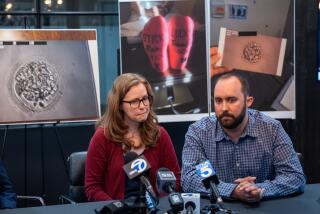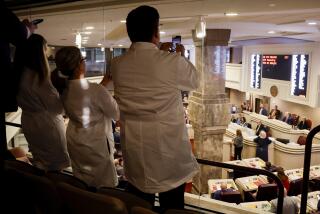Birth of First Frozen Embryo Baby in U.S. Due in June : Two Successful Pregnancies Reported Involving Transfer of Fertilized Eggs From a Laboratory Dish to Mother
- Share via
The first pregnancy achieved in the United States through frozen embryo transfer--a technique in which an embryo is conceived in a laboratory dish, frozen and then thawed and implanted in the mother at a later date--is expected to result in the birth of a healthy baby in June, a Los Angeles doctor announced Thursday.
Dr. Richard Marrs, who directs the in-vitro fertilization and embryo replacement program at Good Samaritan Hospital, made the announcement at a news conference. Marrs also disclosed that a second California woman has become pregnant through use of the same technique and is expected to deliver in December, and in Louisiana, Dr. Steven Taylor of the Fertility Institute of New Orleans said a Gulf Coast woman was in her first trimester after receiving a frozen embryo transplant.
In Los Angeles, Marrs told reporters that the two California women previously had been unable to become pregnant because the tubes that lead from the ovaries to the uterus were blocked, thereby preventing an egg from entering the uterus for fertilization in the normal manner.
Marrs said both of the women had requested that their names, places of residence and descriptions of their families be withheld for reasons of privacy. He said only that one woman is from Southern California and the other from Northern California and that in both cases the women’s eggs were fertilized by their husbands’ sperm. One is 36 years old and the other is 40.
They are the first successful pregnancies among the 30 women Marrs has attempted to implant with frozen embryos.
The first woman had unsuccessfully undergone three previous implantations of embryos before the successful one last October, according to Marrs, who is an assistant professor of obstetrics and gynecology at USC School of Medicine. Embryos that were implanted in October had been frozen four months before being used.
No details of the New Orleans case were immediately available.
The world’s first live birth of a frozen embryo baby occurred last year in Australia. Since then there have been four or five more births in Australia, one in England and two in Holland, according to Marrs.
The freezing occurs 48 to 72 hours after the mother’s egg has been fertilized by her husband’s sperm in a laboratory dish. At that stage, the embryo has developed into 8 to 16 cells and is still only a tiny speck. Usually four to six of the woman’s eggs are fertilized and frozen at the same time, according to Marrs.
Freezing is done in a vat of liquid nitrogen at 384 degrees below zero, Fahrenheit. The vat also acts as a storage container for the embryos for as long as six months. When the mother is in the proper hormonal balance, three or four of the embryos are thawed and implanted in the mother’s uterus by way of the vagina. The procedure requires no surgery, the physician said.
More than one embryo is usually implanted at the same time in order to increase the chances that one will successfully develop.
The procedure is still considered experimental and carries with it the risk of damage to the embryo from the freezing process, he said.
The technique of freezing the embryo for later implant is a relatively new development in in-vitro fertilization, often called “test-tube babies.” In the earliest experiments, the fertilized egg or eggs were implanted in the mother 48 to 72 hours after fertilization in the laboratory dish.
Marrs said the advantage of freezing the embryos is that the chances of twins or triplets are reduced. Another advantage is that frozen embryos may be stored for long periods and used for subsequent implants in the mother if the first implant is not successful.
In order to know what should be done if a patient becomes pregnant while some of her embryos remain unused in a frozen state, each patient is asked before the freezing occurs what she wishes to be done with those embryos, Marrs said.
Her choices are to donate them for use by another childless woman, donate them for research or to leave them alone and allow them to disintegrate. It is not known how long frozen embryos remain viable, he said.
Marrs said that to date no unused embryo has been used for research, but that a number of potential research projects exist. The guidelines that his laboratory would use allows experiments to be conducted through the 14th day of development.
Marrs said there is a need to improve the quality of the embryos by, for example, finding better nutrients that are used to nourish the fertilized egg during the 48 hours to 72 hours before it is frozen. Another research project would be to learn whether ultrasound, a procedure widely used to check fetuses, is truly safe.






